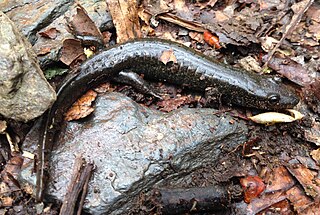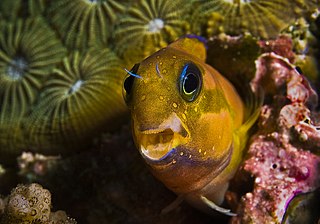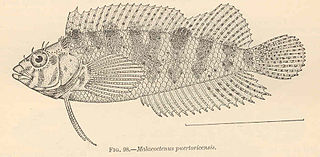
Combtooth blennies are blenniiformids; percomorph marine fish of the family Blenniidae, part of the order Blenniiformes. They are the largest family of blennies with around 401 known species in 58 genera. Combtooth blennies are found in tropical and subtropical waters in the Atlantic, Pacific and Indian Oceans; some species are also found in brackish and even freshwater environments.
Galaxias fuscus, the barred galaxias, is a galaxiid of the genus Galaxias, a member of the Mountain Galaxias species complex group of freshwater fish, found in Australia.

The Alabama waterdog is a medium-sized perennibranch salamander inhabiting rivers and streams of Alabama. It is listed as endangered by the IUCN and the United States Fish and Wildlife Service.

Platycephalus fuscus, the dusky flathead or black flathead, is a large predatory fish and the largest member of the family Platycephalidae. Dusky flathead are a largely estuarine species and are found in estuaries, estuarine lakes and coastal bays on the east coast of Australia, from Cairns in Queensland to the Gippsland Lakes in Victoria. They occur over sand, mud, gravel and seagrass and can inhabit estuarine waters up to the tidal limit.

Desmognathus fuscus is a species of amphibian in the family Plethodontidae. The species is commonly called the dusky salamander or northern dusky salamander to distinguish it from populations in the southern United States which form several distinct species, the southern dusky salamanders. The northern dusky salamander is the most widespread representative of its genus in Canada. It can be found in eastern North America from extreme eastern Canada in New Brunswick south to South Carolina. The size of the species' total population is unknown, but is assumed to easily exceed 100,000. The species' habitat differs somewhat geographically; dusky salamanders in the northern part of the range prefer rocky woodland streams, seepages, and springs, while those in the south favor floodplains, sloughs, and muddy places along upland streams. They are most common where water is running or trickling. They hide under various objects, such as leaves or rocks, either in or near water. Alternatively, they may enter burrows for protection. The dusky salamander lays its eggs close to water under moss or rocks, in logs, or in stream-bank cavities. The larval stage which follows is normally aquatic.

The blackbelly salamander is a species of salamander in the family Plethodontidae. It is endemic to the United States. Its natural habitats are rivers, intermittent rivers, and freshwater springs. It is threatened by habitat loss.

Salarias fasciatus, commonly known as the jewelled blenny or lawnmower blenny is a benthic, neritic, marine fish species endemic to Australasia. Despite being known as the lawnmower blenny, due to its propensity to consume algae growth in aquaria, it is principally a detritivore, with plant material making up only about 15% of its diet. The lawnmower blenny camoflauges with its surroundings, even changing color to hide itself from predators.

Ecsenius lineatus, known commonly as the linear blenny or lined combtooth blenny, is a species of marine fish in the family Blenniidae.

Ecsenius midas, known commonly as the Midas blenny, Persian blenny, lyretail blenny or golden blenny, is a species of marine fish in the family Blenniidae.

The Australian blenny is a small marine blennioid fish of the genus Ecsenius. They are small and reddish brown with a white ventral side. Australian blennies inhabit the shallow marine waters of the tropics. They are often found along the Great Barrier Reef and Coral Sea of Australia.

Atrosalarias is a genus of combtooth blennies found in the western Pacific Ocean and western Indian Ocean.
Atrosalarias hosokawai is a species of combtooth blenny found in coral reefs in the western Pacific Ocean, from Japan to Papua New Guinea. It can reach a maximum length of 74 millimetres (2.9 in) SL.

Istiblennius bellus, the imspringer, is a species of combtooth blenny found in coral reefs in the Pacific and western Indian ocean. It is also known as the beautiful rockskipper or the dusky blenny. Males of this species can reach a maximum of 16 cm (6.3 in) SL, while females reach a maximum of 13.1 cm (5.2 in) SL.

Istiblennius dussumieri, the streaky rockskipper, is a species of combtooth blenny found in coral reefs in the western Pacific and Indian Oceans. It is also commonly known as the Dussumier's rockskipper, streaky dussumier, or the Dussumier's blenny.

Ecsenius pictus, known commonly as the white-lined comb-tooth in Indonesia and the pictus blenny in Micronesia, is a species of combtooth blenny family Blenniidae.
Dialommus fuscus, the Galápagos four-eyed blenny, is a species of labrisomid blenny endemic to the coasts of the Galapagos Islands. It inhabits the intertidal zone where it lives in tide pools as well as traveling on land. Special adaptations of the corneas of the eye and the gill filaments allow this species to travel up to 30 metres (98 ft) from the ocean in search of prey items such as insects and shore-dwelling crabs.

Malacoctenus gilli, the dusky blenny, is a species of labrisomid blenny native to the Atlantic Ocean including the Gulf of Mexico and the Caribbean Sea from the Bahamas to the north coast of South America. This species inhabits reef patches, areas of sandy substrates with available rocks and beds of seagrass at depths of from 1 to 5 metres. It can reach a length of 7.6 centimetres (3.0 in) TL. The person honoured in the patronym of this species was not identified by Steindachner but it is most probably the American ichthyologist Theodore Nicholas Gill (1837-1914), the authority for the generic name Malacoctenus.

Stegastes fuscus, the dusky damselfish, is a species of bony fish in the family Pomacentridae found near the seabed in shallow waters on the western fringes of the Atlantic Ocean.
The blackbelly triplefin is a species of triplefin blenny in the genus Enneapterygius, described by German ichthyologist Ronald Fricke in 1997 and known from the western Pacific Ocean.

The dusky frillgoby, also known as the brown frillfin, is a species of goby which is found in the Indo-Pacific region from the South Africa north to the Red Sea and east as far as Tonga, south to Australia and north to Japan. It is a mainly coastal speciesbut it has an amphidromous life cycle and it occurs in estuaries and will move into in freshwater streams. In estuarine areas it is found mainly in the creeks preferring environments with sand and rubble, soft coral and open reefs. It feeds on detritus, as well as feeding on crustaceans, fish and algae and it is a benthic spawner. The maximum total length is 12 centimetres (4.7 in).

















